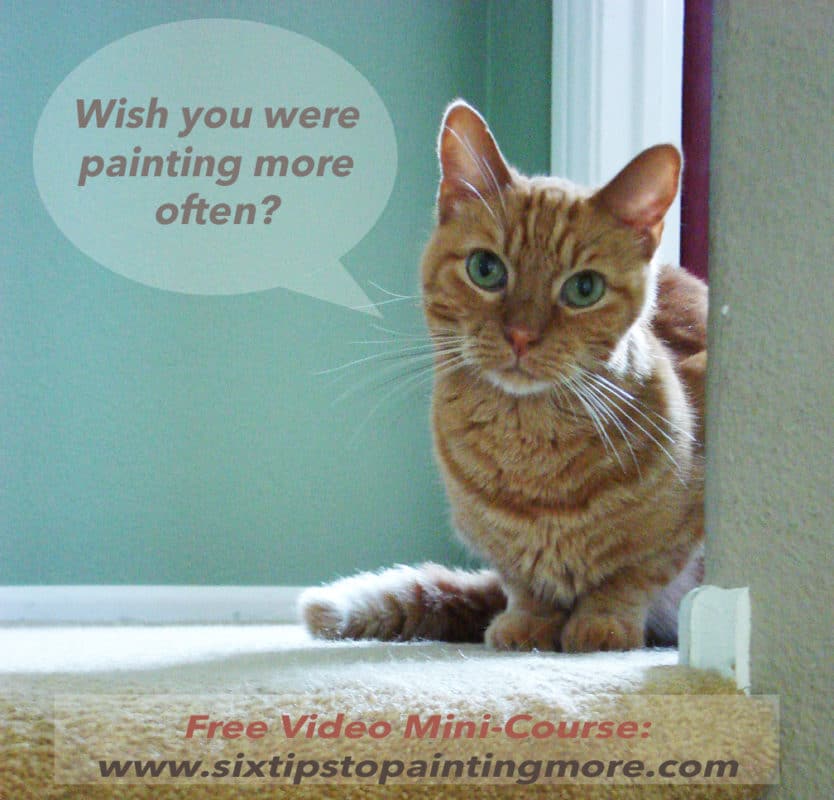Drypoint Etchings on Recycled Plastic Sheets
So far, I’ve experimented with Drypoint etching print from a Trader Joe’s biscotti container here, and a monotype print from a recycled plastic blueberry container here. In this post, we’ll go over how to make a Drypoint Etching (also known as a drypoint engraving) from a plastic lettuce container, and we’ll keep the process super simple. We’ll print the Drypoint without a press, by using a cereal spoon.

Etching and Engraving Tools
Plastic printmaking plates are soft enough to engrave with a sewing needle taped to a chop stick. But if you have the means to get a twisted scribe (see them here on Amazon), I’d recommend adding one to your art supplies.
A stainless scribe will make engraving plastic (or traditional copper) plates much easier, and you’ll have it for the rest of your art-making life.

Recycled Plastic Produce Containers Make Great Drypoint Plates
With a sharp tip held like a pencil, you can draw directly on a sheet of smooth recycled plastic to create a drypoint etching.
If drawing is not your jam, you can lay a photograph underneath your plate, and trace the shapes onto the plastic. (If you do this, it’s a good idea to tape both the photo and the plate to the table to keep the two sandwiched in place while you’re drawing.)
And if holding a scribe or an engraving needle for long periods of drawing time results in aches or pain, you can also use an electric engraver (like this one) to speed up the process.













If You Need a Reason to Buy Cookies
I hope you’ll try this drypoint etching process on a recycled cookie container. It’s fun, relatively quick, and you can print an entire edition at your kitchen table.Let me know in the comments if you’ve tried making one, and leave a link where we can see yours. Also, feel free to leave any questions about the process.
Thanks for stopping by and I’ll see you in the next post!
Belinda
P.S. Watch printmaker Karen Wicks pull two tiny drypoint etchings made from a medication packaging box.

Art Quote
Unsen Mountain is a woodblock print (ca 1927) by Hiroshi Yoshida. Yoshida was an avid traveler, outdoorsman, and hiker, and he captured the beauty of various scenes through these prints. He took inspiration from 19th-century European watercolorists and added Japanese traditional ink painting themes to depict the landscapes. This print (10 x 16) captures the Unsen Mountain from across a river. The low tide of the river exposes the surrounding sand and terrain. Many people are on the sand in their swimming suits and boats are portrayed in the center of the print. The size of the mountains contrasts the small size of the people and emphasizes human interaction with nature. Yoshida also uses this print to depict one of the pastimes of people.
Supply List to Make a Drypoint Etching from Plastic
- Recycled Plastic squares or rectangles from fruit, baked goods or candy containers
- Plexiglass (if you can’t find recycled plastic – try perspex, optix, lexan, etc.)
- Twisted Scribe (or Whistler’s Needle)
- Cork Handled Etching Needle/Scribe (this one was used in the video)
- Akua MagMix (modifier to thicken the ink)
- Akua Transparent Base (this modifier thins the color in any of your pigments to print very soft and transparent)
- Storage jars for leftover ink
- Apron (this is my favorite linen apron, ever)
- Putty knife/scraper (for mixing ink colors)
- Printmaking paper BFK Rives paper (lightweight) for use with hand rub/transfer (*recommended if you plan to add wet media like watercolor*)
- If you won’t be adding wet media, you can try Japanese kozo paper
- daubers or “dollies”: rolled strips of felt for ink application
- (Visit this post if you’d like instructions on how to make a felt dauber for intaglio printmaking.)
- or you can use bristle paint brushes


Again, bless you, Belinda!
Hi Belinda. I’ve been experimenting with drypoint using your instructions above. Thank you so much! I was able to get some acrylic offcuts from a local picture framer and they work great for the plate. How many prints should I be able to get off one inking of the plate? I’m hoping to make some Christmas cards. Thank you for sharing your talent and information so freely. It’s truly appreciated.
I have saved this to FINALLY review and I can hardly wait to do this!! I love your demos that repurpose materials destined for the trash bin or recycling bucket! When our class re-convenes once COVID has relinquished its hold on everyone – I want to try with them. This looks super fun, and since I don’t have access to a press yet – perfect to try! Thanks so much Belinda – and have a Happy Thanksgiving everyone.
Hi MaryLiz! I’m so glad you’re going to give this a go. I just made another one at the kitchen counter, and they are so FUN! The notion that you’re rescuing something from the trash, and it didn’t cost anything extra beyond the contents of the container, which has been consumed (especially if it was cookies!) – is quite freeing! Have a wonderful Thanksgiving, and thanks again for stopping in!
Love your quirky monster collage on the drypoint on food containers. Art should be fun!
Hi Robyn! Yes, let’s focus on the fun! As they say – do it for the process. Experimentation along the way informs everything upcoming. Thank you for the compliments.